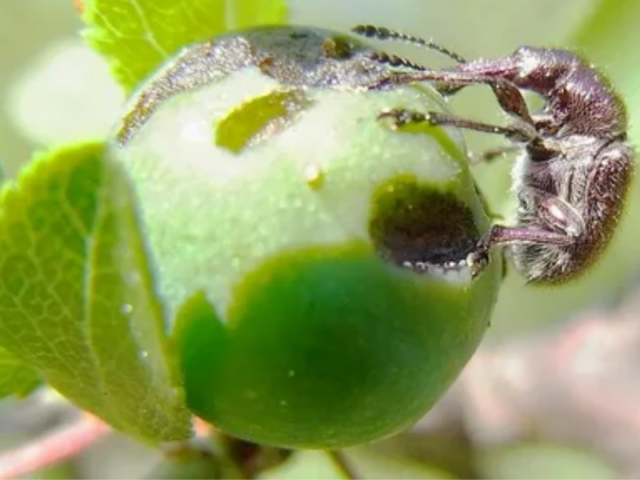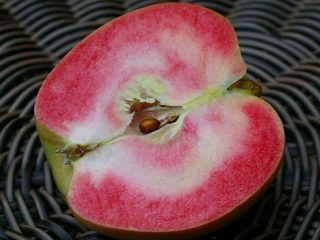Content
The Honey Crisp apple tree is one of the winter varieties loved by gardeners in many countries, whose name translated from English means “Honey Crunch.” It is the pleasant sweet taste that gardeners call the hallmark of this crop.

The branches of an adult Honey Crisp apple tree are densely strewn with fruits
History of selection
The Honey Crisp variety was created in 1974 as a result of crossing the Macoun and Honey Gold apple trees. The originators were breeders from Minnesota (United States of America).
Having successfully overcome all experimental tests in the early eighties of the last century, the Honey Crisp apple tree quickly gained popularity among gardeners in America and Western Europe. In the early nineties, representatives of this variety appeared in the gardens of Russia and the countries of the former CIS.

The breeders' task was to breed frost-resistant apple trees with a long shelf life
Description and characteristics of the Honey (Hani) Crisp apple tree
Pleasant taste and good characteristics have helped the Honey Crisp apple tree to become one of the most popular winter varieties. Good transportability and a record shelf life of the fruit played an important role in this.
Wood appearance
The winter apple tree Honey Crisp is a medium-sized tree, the maximum height of which does not exceed 4.5 m.
To facilitate care and harvesting, it is allowed to grow apple trees of this variety on a rootstock. The height of the tree on a dwarf rootstock is no more than 2.5, and on a semi-dwarf rootstock - 3.5 m.
Thin long shoots of Honey Crisp are located mainly at right angles to the trunk.
Due to the high ability of shoot formation, the narrow pyramidal or spindle-shaped crown thickens very quickly in the first years of the tree’s life, which necessitates regular formative pruning. If it is carried out correctly, by the fifth year of life the crown becomes broadly oval.
Like most representatives of this culture, the bark of a young Honey Crisp apple tree has a brown-green tint, turning into brown-brown as it matures. In addition, over time it becomes susceptible to cracking.
The dark green leaves of Honey Crisp are large and matte. The shape of the leaf blade is typical for this crop - round-oval with a pointed end and a serrated edge.
The branched root system of the apple tree is located in the upper layers of the soil. The presence of a central rod depends on the characteristics of cultivation (when growing on a rootstock, it is recommended to pinch out the central root).

Honey Crisp is rarely grown on natural apple rootstock.
Description of fruits
The rounded, elongated, equilateral, sometimes slightly flattened fruits of the Honey Crisp variety are quite large - the weight of one apple varies between 180-250 g.
Light green at the stage of milky ripeness, as they ripen, the color of the dense glossy skin of apples becomes honey-yellow with an extensive bright red or burgundy blush and small light inclusions.
The dense, juicy pulp at the stage of full maturity has a creamy, sometimes yellowish tint; when bitten, it easily breaks with a crunch (in fact, this is why the variety received the name “Honey Crunch”).
The taste of ripe apples is pleasant, honey-like, with a barely noticeable sourness. The tasting commission described it as a sweet dessert and rated it 4.8 points.

Honey Crisp apples have an attractive appearance
Bloom
The flowering period begins in early, middle or late May. This depends on the climatic conditions of the growing region and the weather in the current season. The decisive factor is the ambient air temperature - the flowers on the trees will open no sooner than the thermometer rises to 15 °C.
During the budding period, which lasts 1-2 weeks, the tree is covered with a huge number of large white inflorescences, emitting an intense, pleasant aroma.

Apple tree flowers are large, five-petaled
Pollinators of the Honey Crisp apple tree
The Honey Krispy variety is characterized as self-sterile, so so-called pollinating plants are needed to fertilize the flowers.In this regard, apple trees of other varieties are planted in close proximity to the tree.
Suitable neighbors for Honey Crispy would be the Everest, Gloucester, Idared apple trees, Askold's granddaughter.
When grown on a production scale, some gardeners practice artificial pollination.
Ripening time
The fruiting period of the Honey Krispy apple tree is extended. The first apples ripen around the second half of September, and the last ones - in the second half of October.
Productivity
Gardeners characterize the yield level of the variety as average. The Honey Crispy apple tree begins to bear fruit very early, especially if it is grown on a vegetative rootstock.
In the first and second years after planting there will be few apples, but under favorable weather conditions and proper agricultural technology, about 10 kg of ripe fruit can be harvested from a 4-5-year-old tree. The apple tree will produce a full harvest (35-40 kg) approximately in the eighth year of its life.

Apples retain their presentation and taste for a long time
Frost resistance
The Honey Crisp variety is characterized as frost-resistant. Mature apple trees grown on conventional vegetative rootstock are able to withstand temperatures as low as -35 °C. The cold resistance of dwarf and semi-dwarf crops is slightly lower.
A decrease in this indicator is possible as a result of:
- overload of fruits in the current season;
- weakening of the tree as a result of diseases and harmful activities of insects;
- mechanical damage;
- lack of nutrition (this can happen during the dry season).
Disease resistance
The Honey Krispy apple tree is practically not infected with scab. But powdery mildew and other fungal diseases can cause considerable harm to it.
In addition, the tree often becomes the target of pest attacks. All this makes it necessary to carry out preventive measures (cleaning the root zone of rotting fruits and fallen leaves, as well as regular treatment of the trunk and crown with special preparations).
Advantages and disadvantages
Photos and descriptions of the Honey Crisp apple variety attract the attention of many gardeners. This can be explained by a number of cultural advantages.

One of the advantages of the apple tree is its compactness.
Pros:
- precociousness and rapid increase in yield;
- presentation and excellent taste of the fruit;
- good shelf life of fruits and the ability to withstand transportation over long distances;
- long shelf life (about six months);
- high level of resistance to drought and low temperatures;
- the presence of immunity to some fungal diseases.
Minuses:
- not very high yield;
- the need for annual pruning;
- possibility of fruit shedding;
- development of subcutaneous spotting of apples during long-term storage.
Planting a Honey Crisp apple tree
The winter apple tree Honey Crispy loves sunlight, so it is recommended to choose a sunny and well-ventilated area for its cultivation.
Any soil can be used except acidic. An acidity pH level above 7 units risks becoming detrimental to seedlings.
Apple trees can be planted twice a year - in the spring, when the soil warms up to 10 °C, and in the fall, during leaf fall.
During work:
- dig a hole approximately 80x80, put drainage on the bottom, and then fill it with a nutrient mixture consisting of garden turf, compost and wood ash;
- spill the hole with water, place the seedling in it and fill it with soil so that the root collar protrudes 2-3 cm above the soil surface;
- The soil is lightly compacted and watered again.
A wooden peg is driven into the ground nearby and a young apple tree is tied to it.

It is advisable to choose seedlings in pots
Features of care
Aftercare for Honey Krispy apple trees is not particularly difficult.
Mature trees practically do not need regular soil moisture. Honey Krispy apple trees should be watered exclusively during dry periods and autumn (abundant moisture-recharging watering).
Loosening the soil and removing weeds is encouraged, but also not mandatory. But Honey Crisp will have to be pruned every year. During the first procedure, the central stem is cut by 1/3, and the lateral skeletal branches are also shortened. This procedure is repeated every year, adding to it the removal of tops (vertically located shoots) and thickening branches (growing inside the crown). Dry and damaged parts of the tree are also subject to pruning.

Honey Krispy apple trees are pruned before sap flow begins.
Diseases and pests
Adverse weather conditions and improper care can cause the development of diseases. The Honey Krispie apple tree is not spared by pests.
Powdery mildew
The presence of the disease can be determined by the white coating that first appears on the leaves of the Honey Crispy apple tree, and later affects the shoots and fruits.Treatment with fungicidal preparations such as Fundazol, Guardian, Tiovit Jet will help cope with the disease.

If powdery mildew is not treated, it risks causing the death of the tree.
Green aphid
Small green insects, almost invisible to the naked eye, can cause significant damage to the plant if they are not eliminated in time. Treating the Honey Crisp apple tree with insecticidal preparations such as Karbofos and Fitoverm will help to do this.

Clumps of aphids can be found on the underside of a Honey Krispy apple leaf.
Flower beetle
Small (up to 0.5 cm) brown bugs are dangerous because, climbing inside the apple tree flower, they eat away its core. As a result of such activity, the ovary is not formed. After the end of the flowering period, the flower beetle begins to devour the leaves.

The flower beetle eats not only flowers and leaves, but also the fruits of the Honey Crisp apple tree
You can get rid of this insect, as well as other pests, by treating the Honey Krispy apple tree with insecticides.
Collection and storage
Given the extended ripening period, Honey Crisp apples are harvested in several stages. The ripeness of fruits is determined by how easily they separate from the stalk. If you have to pull the apple, it’s too early to pick it.
Ripe Honey Krispy fruits are placed in a wooden container, layered with dry sawdust or covered with paper. Store Honey Krispy apples in a dry, cool and well-ventilated area.

One of the advantages of the Honey Krispy variety is its long shelf life.
Conclusion
The Honey Crisp apple tree is an unpretentious plant that, with proper care, can provide juicy fresh apples throughout the winter. Good frost resistance allows this variety to be grown in almost all regions of the country.
Reviews from gardeners about the Honey (Hani) Crisp apple tree









Will the Vasyugan and Valyuta apple trees be able to become pollinators for Honney Crisp?
Good afternoon.
No, neither Vasyugan nor Valyuta will be able to pollinate the Honey Crisp apple tree.